Richmond, California, Hgh State Clinic, Hgh Injections, Hrt Doctors
Richmond, California Blood Testing Facilities
 Represents a LabCorp blood testing facility
Represents a LabCorp blood testing facility Represents a Quest Diagnostics blood testing facility
Represents a Quest Diagnostics blood testing facility

Nearby Labcorp Blood Testing facilities:
- Labcorp Center Distance: 1 m, 2089 Vale Rd Ste 14, San Pablo, Contra Costa County, CA, 94806
- Labcorp Center Distance: 4 m, 2160 Appian Way Ste 205, Pinole, Contra Costa County, CA, 94564
- Labcorp Center Distance: 7 m, 2850 Telegraph Ave Ste 212, Berkeley, Alameda County, CA, 94705
- Labcorp Center Distance: 9 m, 55 Francisco St. Suite 430, San Francisco, San Francisco County, CA, 94133
- Labcorp Center Distance: 10 m, 728 Pacific Ave. Suite 401, San Francisco, San Francisco County, CA, 94133
- Labcorp Center Distance: 11 m, 150 Glen Cove Marina Rd. 105, Vallejo, Solano County, CA, 94591
- Labcorp Center Distance: 12 m, 148 Noe Street, San Francisco, San Francisco County, CA, 94114
- Labcorp Center Distance: 13 m, 1367 East Second Street, Benicia, Solano County, CA, 94510
- Labcorp Center Distance: 14 m, 401 Gregory Lane Suite 136, Pleasant Hill, Contra Costa County, CA, 94523
- Labcorp Center Distance: 15 m, 2622 Ocean Ave., San Francisco, San Francisco County, CA, 94132
- Labcorp Center Distance: 16 m, 1601 Ygnacio Valley Road, Walnut Creek, Contra Costa County, CA, 94598
- Labcorp Center Distance: 17 m, 500 Lennon Lane, Walnut Creek, Contra Costa County, CA, 94598
- Labcorp Center Distance: 18 m, 13847 E 14Th St Suite 100, San Leandro, Alameda County, CA, 94578
- Labcorp Center Distance: 20 m, 5161 Clayton Road Ste H, Concord, Contra Costa County, CA, 94520
- Labcorp Center Distance: 21 m, 907 San Ramon Valley Blvd 102, Danville, Contra Costa County, CA, 94526
- Labcorp Center Distance: 23 m, 2305 Camino Ramon Ste 110, San Ramon, Contra Costa County, CA, 94583
- Labcorp Center Distance: 25 m, 4165 Blackhawk Plz Circle 165, Danville, Contra Costa County, CA, 94506
- Labcorp Center Distance: 26 m, 153 Lynch Creek Way, Petaluma, Sonoma County, CA, 94954
- Labcorp Center Distance: 27 m, 3448 Villa Lane Suite 103, Napa, Napa County, CA, 94558
- Labcorp Center Distance: 29 m, 4045 Lone Tree Way Ste B, Antioch, Contra Costa County, CA, 94531
- Labcorp Center Distance: 31 m, 1048 El Camino Real Suite B, Redwood City, San Mateo County, CA, 94063
- Labcorp Center Distance: 32 m, 2147 Mowry Ave Ste C1, Fremont, Alameda County, CA, 94538
- Labcorp Center Distance: 33 m, 1370 Medical Center Dr Ste B, Rohnert Park, Sonoma County, CA, 94928
- Labcorp Center Distance: 35 m, 853 Middlefield Rd Ste 6, Palo Alto, Santa Clara County, CA, 94301
- Labcorp Center Distance: 38 m, 4769 Hoen Avenue, Santa Rosa, Sonoma County, CA, 95405
- Labcorp Center Distance: 39 m, 1111 Sonoma Ave Ste 121, Santa Rosa, Sonoma County, CA, 95405
- Labcorp Center Distance: 41 m, 2500 Hospital Dr Bldg 11, Mountain View, Santa Clara County, CA, 94040
- Labcorp Center Distance: 42 m, 3540 Mendocino Ave Ste 400, Santa Rosa, Sonoma County, CA, 95403
- Labcorp Center Distance: 47 m, 316 Rosewood Ave. 2Nd Floor, San Jose, Santa Clara County, CA, 95117
- Labcorp Center Distance: 48 m, 8465 Old Redwood Hwy Ste 400, Windsor, Sonoma County, CA, 95492
- Labcorp Center Distance: 49 m, 50 E. Hamilton Ave. Suite 80, Campbell, Santa Clara County, CA, 95008
- Labcorp Center Distance: 50 m, 777 Knowles Dr Ste 4, Los Gatos, Santa Clara County, CA, 95032
- Labcorp Center Distance: 51 m, 2585 Samaritan Dr Ste 103, San Jose, Santa Clara County, CA, 95124
- Labcorp Center Distance: 52 m, 2060 Aborn Rd Ste 200, San Jose, Santa Clara County, CA, 95121
- Labcorp Center Distance: 55 m, 393 Blossom Hill Rd Ste 350, San Jose, Santa Clara County, CA, 95123
- Labcorp Center Distance: 56 m, 6489 Camden Ave Ste 107, San Jose, Santa Clara County, CA, 95120
- Labcorp Center Distance: 57 m, 1617 N. California Street, Stockton, San Joaquin County, CA, 95204
- Labcorp Center Distance: 62 m, 8100 Timberlake Way Ste E, Sacramento, Sacramento County, CA, 95823
- Labcorp Center Distance: 66 m, 500 University Ave 2Nd Fl, Sacramento, Sacramento County, CA, 95825
- Labcorp Center Distance: 67 m, 2 Scripps Dr. Suite 303, Sacramento, Sacramento County, CA, 95825
- Labcorp Center Distance: 68 m, 1505 Soquel Dr Ste 3, Santa Cruz, Santa Cruz County, CA, 95065
- Labcorp Center Distance: 75 m, 272 Green Valley Road, Freedom, Santa Cruz County, CA, 95019
- Labcorp Center Distance: 76 m, 1541 Florida Ave. Suite 102, Modesto, Stanislaus County, CA, 95350
- Labcorp Center Distance: 77 m, 700 W. 6Th St. Ste E, Gilroy, Santa Clara County, CA, 95020
- Labcorp Center Distance: 81 m, 1008 Riley St Ste 4, Folsom, Sacramento County, CA, 95630
- Labcorp Center Distance: 82 m, 1600 Creekside Dr Ste 3500, Folsom, Sacramento County, CA, 95630
- Labcorp Center Distance: 86 m, 89 Lincoln Blvd., Lincoln, Placer County, CA, 95648
- Labcorp Center Distance: 87 m, 1801 Colorado Ave. Suite 200, Turlock, Stanislaus County, CA, 95382
- Labcorp Center Distance: 94 m, 1326 Natividad Rd. Suite A, Salinas, Monterey County, CA, 93906
- Labcorp Center Distance: 95 m, 559 E. Alisal St. Ste 104, Salinas, Monterey County, CA, 93905
- Labcorp Center Distance: 96 m, 11930 Heritage Oak Pl Ste 7, Auburn, Placer County, CA, 95603
Nearby Quest Blood Testing facilities:
- Quest Center Distance: 6 m, 500 Alfred Nobel Drive, Hercules, Contra Costa County, CA, 94547-1839
- Quest Center Distance: 9 m, 3300 Webster St, Oakland, Alameda County, CA, 94609-3106
- Quest Center Distance: 10 m, 1000 S Eliseo Dr, Greenbrae, Marin County, CA, 94904-2133
- Quest Center Distance: 11 m, 2201 Post St, San Francisco, San Francisco County, CA, 94115-3427
- Quest Center Distance: 12 m, 2198 15Th St, San Francisco, San Francisco County, CA, 94114-1213
- Quest Center Distance: 13 m, 2042 Columbus Pkwy, Benicia, Solano County, CA, 94510-5400
- Quest Center Distance: 14 m, 401 Gregory Ln, Pleasant Hill, Contra Costa County, CA, 94523-2836
- Quest Center Distance: 16 m, 108 La Casa Via, Walnut Creek, Contra Costa County, CA, 94598-3013
- Quest Center Distance: 17 m, 2425 East Street, Concord, Contra Costa County, CA, 94520-1925
- Quest Center Distance: 20 m, 901 Campus Dr, Daly City, San Mateo County, CA, 94015-4930
- Quest Center Distance: 21 m, 20400 Lake Chabot Rd, Castro Valley, Alameda County, CA, 94546-5314
- Quest Center Distance: 23 m, 120 S El Camino Real, Millbrae, San Mateo County, CA, 94030-3133
- Quest Center Distance: 25 m, 1241 East Hillsdale Blvd, Foster City, San Mateo County, CA, 94404-0000
- Quest Center Distance: 26 m, 1550 Professional Drive, Petaluma, Sonoma County, CA, 94954-6655
- Quest Center Distance: 28 m, 5720 Stoneridge Mall Road, Pleasanton, Alameda County, CA, 94588-2851
- Quest Center Distance: 30 m, 1100 Laurel Street, San Carlos, San Mateo County, CA, 94070-5000
- Quest Center Distance: 32 m, 556 Mowry Avenue, Fremont, Alameda County, CA, 94536-4186
- Quest Center Distance: 34 m, 770 Mason St, Vacaville, Solano County, CA, 95688-4648
- Quest Center Distance: 35 m, 1181 Central Boulevard, Brentwood, Contra Costa County, CA, 94513-2252
- Quest Center Distance: 39 m, 990 Sonoma Ave, Santa Rosa, Sonoma County, CA, 95404-4813
- Quest Center Distance: 41 m, 205 South Dr, Mountain View, Santa Clara County, CA, 94040-4323
- Quest Center Distance: 42 m, 649 E Calaveras Blvd, Milpitas, Santa Clara County, CA, 95035-7708
- Quest Center Distance: 43 m, 877 W Fremont Avenue, Sunnyvale, Santa Clara County, CA, 94087-2332
- Quest Center Distance: 47 m, 123 Disalvo Ave, San Jose, Santa Clara County, CA, 95128-1717
- Quest Center Distance: 48 m, 2618 Alum Rock Ave, San Jose, Santa Clara County, CA, 95116-2621
- Quest Center Distance: 49 m, 840 Willow St, San Jose, Santa Clara County, CA, 95125-2384
- Quest Center Distance: 51 m, 2365 Quimby Rd, San Jose, Santa Clara County, CA, 95122-1337
- Quest Center Distance: 55 m, 1708 W Hammer Ln, Stockton, San Joaquin County, CA, 95209-2922
- Quest Center Distance: 57 m, 510 E. Magnolia Street, Stockton, San Joaquin County, CA, 95202-1850
- Quest Center Distance: 59 m, 801 S Ham Ln, Lodi, San Joaquin County, CA, 95242-7502
- Quest Center Distance: 60 m, 1837 E Gibson Rd, Woodland, Yolo County, CA, 95776-5168
- Quest Center Distance: 62 m, 8191 Timberlake Way, Sacramento, Sacramento County, CA, 95823-5418
- Quest Center Distance: 67 m, 50 East Main Avenue, Morgan Hill, Santa Clara County, CA, 95037-3661
- Quest Center Distance: 68 m, 1595 Soquel Drive, Santa Cruz, Santa Cruz County, CA, 95065-1720
- Quest Center Distance: 69 m, 2288 Auburn Boulevard, Sacramento, Sacramento County, CA, 95821-1619
- Quest Center Distance: 73 m, 1045 Sperry Ave, Patterson, Stanislaus County, CA, 95363-9286
- Quest Center Distance: 75 m, 202 Green Valley Rd, Freedom, Santa Cruz County, CA, 95019-3135
- Quest Center Distance: 76 m, 1524 Mchenry Ave, Modesto, Stanislaus County, CA, 95350-4566
- Quest Center Distance: 79 m, 2531 E Whitmore Ave, Ceres, Stanislaus County, CA, 95307-2646
- Quest Center Distance: 82 m, 1600 Creekside Drive, Folsom, Sacramento County, CA, 95630-3445
- Quest Center Distance: 87 m, 777 E Hawkeye Ave, Turlock, Stanislaus County, CA, 95380-7507
- Quest Center Distance: 89 m, 1025 Bridge St, Colusa, Colusa County, CA, 95932-2870
- Quest Center Distance: 90 m, 223 Clinton Rd, Jackson, Amador County, CA, 95642-2603
- Quest Center Distance: 93 m, 631 E Alvin Dr, Salinas, Monterey County, CA, 93906-3056
- Quest Center Distance: 95 m, 757 Pacific St, Monterey, Monterey County, CA, 93940-2819
- Quest Center Distance: 96 m, 3133 Professional Drive, Auburn, Placer County, CA, 95603-2463
California Hormone Replacement Therapy Services
Hormone Imbalance is a significant medical issue that many people don't consider as thoughtfully as they should. Do you feel that your body and mind are slowing down as you grow older, and do you want to do something about it?
The Conscious Evolution Institute can quickly and discreetly provide you with Physician-Monitored Hormone Replacement Therapy Solutions. We offer a number of plans and programs which have been proven to help improve the lives and wellness of millions across the United States and the World.
Testosterone Therapy in California
As we grow older, our hormone levels start to decline naturally as a result of age. Starting around the age of thirty, men can start to suffer from a decline in physical and sexual health resulting directly from Low-T. If you are experiencing a lack of sex drive or symptoms of Erectile Dysfunction, this could be the tip of the iceberg of a number of different medical problems which can have a significantly negative impact on your health and longevity.
Testosterone Deficiency can even impact female health! Especially in the areas of sexual and cardiovascular health.
HGH Replacement in California
Like Testosterone, Growth Hormone Levels also start to decline with age, to the great detriment of our health. HGH sustains the cellular metabolism of the body, feeding us energy and allowing our bodies to rebuild and rehabilitate. As HGH Levels drop, our body goes into physiological decline because it simply can't keep up with the demands of day-to-day life.
Bio-Identical Growth Hormone Injections can restore healthy adult HGH concentrations, giving the body the raw resources needed to amplify health and wellness and preserve the human body from the effects of premature aging.
Sermorelin Injections in California
Sermorelin is an alternative to Human Growth Hormone, which fulfills the same goal of mitigating the effects of Growth Hormone Deficiency. Rather than replace HGH directly, Sermorelin Acetate stimulates the body to produce more of this precious hormone, while the body still has the ability to regulate HGH Release to make sure that the body gets the optimal level of Growth Hormone.
California HCG Diet
For men and women that are looking for a way to effectively and quickly lose weight, the Conscious Evolution Institute offers HCG Injection Therapy, which, when combined with an effective and specifically-designed diet, encourages the body to rapidly burn fat while sustaining energy and limiting the sensation of hunger, making dieting much more manageable.
Major Metropolitan Areas of California
Los Angeles
Los Angeles California, also known as Tinseltown, the City of Angels, or simply L.A., is the largest metropolitan area in the state of California. The city is known for having a near-insurpassable level of glitz and glamor, and the city is probably most widely known around the world for Hollywood, the center of the global film world, where actors and directors come together to produce films with the largest budgets the world has ever seen.
The L.A. Metro is home to a number of different professional sports teams, such as the L.A. Lakers, the L.A. Clippers, and the Los Angeles Angels of Anaheim. Los Angeles is also home to the Dodgers, who moved to California from Brooklyn, New York in 1957.
San Francisco
San Francisco is widely considered one of the most unique cities in the United States, and is the second largest city in the state of California. In terms of raw diversity, there is probably no place in the United States more diverse than San Francisco, except for Queens New York. The culture of San Francisco is highly politically active and people aren't afraid to voice their concerns under any circumstances.
The city is also home to a number of pro sports teams including the San Francisco 49ers and the Giants. The Oakland Raiders, Golden State Warriors, and Oakland As play just across the San Francisco Bay. The most famous place in San Francisco is, by far, the Golden Gate Bridge, which connects San Francisco to the Golden Gate Recreational Area to the north of the city.
San Diego
San Diego is the third largest metro in the state of California, and is the furthest south of all of the major cities in the state, immediately bordering Mexico to the south. Immediately south of San Diego is Tijuana, Mexico, and beyond that is Baja California.
San Diego's economy is driven heavily by its United States Military Presence and its busy deep-water harbor. San Diego is actually the only city on the west coast which has a shipyard which builds military ships and submarines. San Diego is home to two professional sports teams, the San Diego Padres and the Chargers.
Riverside
Riverside is the largest inland metro area in California, and the fourth largest in the state. Although Riverside itself is relatively small in comparison to the other, larger cities of the state, Riverside is the key city in a highly populated region known as the Inland Empire. Other major cities include San Bernadino and Ontario, California.
Unlike most major metros in the state and the country, the Inland Empire represents a large number of cities that grew close and simultaneously, and Riverside also belongs to a census area known as the Greater Los Angeles Area, one of the largest in the country with more than 7 million people.
Sacramento
Sacramento is the fifth largest metro area in the state of California and is located inland about 85 miles northeast of San Francisco. The city is also the capital of California. Like San Francisco, Sacramento is hailed as a highly diverse city, and is frequently recognized as one of the most well-integrated cities in the United States.
Sacramento is home to a single professional sports team, the Sacramento Kings. The city also has a highly active rock culture, contributing artists such as Cake and the Deftones to the national scene. The city also has a large theatrical scene, including the Sacramento Ballet, the B-Street Theater, and the Sacramento Shakespeare Festival.
All About Richmond, California Geographic Area
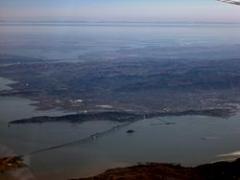
Richmond ( /ËnrɪtÊcmÉond/ RICH-mÉond) is a city in western Contra Costa County, California, United States. The city was incorporated on August 7, 1905. It is located in the East Bay, part of the San Francisco Bay Area. It is the site of heavy industry, which has been undergoing a shift towards a service and commercial economy since the 1970s. Richmond almost completely surrounds the city of San Pablo and the unincorporated areas of North Richmond, El Sobrante and East Richmond Heights. The city has a reputation for being crime-plagued, although this problem is centralized in the urban core, with many parts of Richmond having a low crime rate. The city's own police department, however, has described the city as having a chronic violent crime problem for "decades." In 2010, Richmond was ranked the 6th most dangerous city in the United States.
/ËnrɪtÊcmÉond/ RICH-mÉond) is a city in western Contra Costa County, California, United States. The city was incorporated on August 7, 1905. It is located in the East Bay, part of the San Francisco Bay Area. It is the site of heavy industry, which has been undergoing a shift towards a service and commercial economy since the 1970s. Richmond almost completely surrounds the city of San Pablo and the unincorporated areas of North Richmond, El Sobrante and East Richmond Heights. The city has a reputation for being crime-plagued, although this problem is centralized in the urban core, with many parts of Richmond having a low crime rate. The city's own police department, however, has described the city as having a chronic violent crime problem for "decades." In 2010, Richmond was ranked the 6th most dangerous city in the United States.
The city is headed by mayor Gayle McLaughlin, making Richmond the largest city in the country with a Green Party mayor. As of the 2010 U.S. Census, the city's population is at 103,701. This makes Richmond the 61st largest city in the state. Richmond has been called a company town based on its relationship with Chevron Corporation and has been referred to as "Refinery Town".
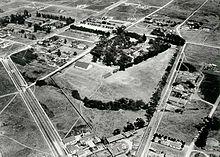
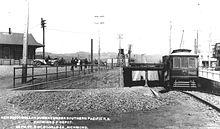
The Ohlone Indians were the first inhabitants of the Richmond area, settling an estimated 5,000 years ago.
The name "Richmond" appears to predate actual incorporation by more than fifty years. Edmund Randolph, originally from Richmond, Virginia, represented the city of San Francisco when California's first legislature met in San Jose in December 1849, and he became state assemblyman from San Francisco. His loyalty to the town of his birth caused him to persuade a federal surveying party mapping the San Francisco Bay to place the names "Point Richmond" and "Richmond" on an 1854 geodetic coast map, which was the geodetic map at the terminal selected by the San Francisco and San Joaquin Valley Railroad; and by 1899 maps made by the railroad carried the name "Point Richmond Avenue," designating a county road that later became Barrett Avenue, a central street in Richmond.
The Atchison, Topeka and Santa Fe Railroad had its terminus at Richmond. The first post office opened in 1900.
Richmond was founded and incorporated in 1905, carved out of Rancho San Pablo, from which the nearby town of San Pablo inherited its name. Until the enactment of prohibition in 1919, the city had the largest winery in the world; the small abandoned village of Winehaven remains fenced off along Western Drive in the Point Molate Area. In the 1920s the Ku Klux Klan was active in the city. In 1930 the Ford Motor Company opened an assembly plant which moved to Milpitas in the 1960s. The old Ford plant has been a National Historic Place since 1988, and has recently[when?] been converted into an events center (Ford Point Building ae The Craneway). The city was a small town at that time, until the onset of World War II which brought on a rush of migrants and a boom in the industrial sector. Standard Oil set up operations here in 1901, including a what is now the Chevron Richmond Refinery and tank farm, which are still operated by Chevron. There is a pier into San Francisco Bay south of Point Molate[disambiguation needed] for oil tankers. The western terminus of the Santa Fe Railroad was established in Richmond with ferry connections at Ferry Point in the Brickyard Cove area of Point Richmond to San Francisco.
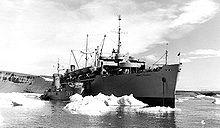
At the outset of World War II, the four Richmond Shipyards were built along the Richmond waterfront, employing thousands of workers, many recruited from all over the United States, including many African-Americans and women entering the workforce for the first time. Many of these workers lived in specially constructed houses scattered throughout the San Francisco Bay Area, including Richmond, Berkeley and Albany. A specially built rail line, the Shipyard Railway, transported workers to the shipyards. Kaiser's Richmond shipyards built 747 Victory and Liberty ships for the war effort, more than any other site in the U.S. The city broke many records and even built one Liberty ship in a record five days. On average the yards could build a ship in thirty days. The medical system established for the shipyard workers at the Richmond Field Hospital eventually became today's Kaiser Permanente HMO. It remained in operation until 1993 when it was replaced by the modern Richmond Medical Center hospital, that has subsequently expanded to a large multiple building campus.
Point Richmond was originally the commercial hub of the city, but a new downtown arose in the center of the city. It was populated by many department stores such as Kress, J.C. Penney, Sears, Macy's, and Woolworth's. During the war the population increased dramatically and peaked at around 120,000 by the end of the war. Once the war ended the shipyard workers were no longer needed, beginning a decades-long population decline. The Census listed 99,545 residents in 1950. By 1960 much of the temporary housing built for the shipyard workers was torn down, and the population dropped to about 71,000. Many of the people who moved to Richmond were black and came from the Midwest and South. Most of the white men were overseas at war, and this opened up new opportunities for ethnic minorities and women. This era also brought with it the innovation of daycare for children, as a few women could care for several dozen women's children, while most of the mothers went off to work in the factories and shipyards.
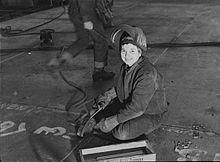
In the 1970s the Hilltop area including a large shopping mall was developed in the northern suburbs of the city; this further depressed the downtown area as it drew away retail clients and tenants. In the late 1990s and early 2000s the Richmond Parkway was built along the western industrial and northwestern parkland of the city connecting Interstates 80 and 580.
In the early 1900s, the Santa Fe railroad established a major rail yard adjacent to Point Richmond. The railroad constructed a tunnel through the Potrero San Pablo ridge to run a track from their yard to a ferry landing from which freight cars could be transshipped to San Francisco. Where this track crosses the main street in Point Richmond, there remain two of the last operational wigwag grade crossing signals in the United States, and the only surviving examples of the "upside-down" type. The wigwag is an antiquated type of railroad crossing signal which was phased out in the 1970s and 80s across the country. There was controversy in 2005 when the State Transportation Authority ordered the BNSF railroad company to upgrade the railroad crossing signals. A compromise was achieved that included installing new modern crossing gates, red lights and bells while not removing, but simply shutting off the historic ones and preserving their functionality for special events.
The Pullman Company also established a major facility in Richmond in the early 20th century. The facility connected with both the Santa Fe and Southern Pacific and serviced their passenger coach equipment. The Pullman Company was a large employer of African American men, who worked mainly as porters on the Pullman cars. Many of them settled in the East Bay, from Richmond to Oakland, prior to World War II.
Martin Luther King, Jr. had planned to visit Richmond just prior to his assassination.
In 2006 the city celebrated its centennial. This coincided with the repaving and streetscaping project of Macdonald Avenue. The city's old rundown commercial district along Macdonald has been designated the city's "Main Street District" by the state of California. This has led to funding of improvements in the form of state grants.
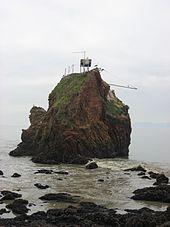
Richmond is located at 37 °56 a²09 a³N 122 °20 a²52 a³W / 37.93583 °N 122.34778 °W / 37.93583; -122.34778.
According to the United States Census Bureau, the city has a total area of 52.5 square miles (136 km2), of which 30.1 square miles (78 km2) is land and 22.4 square miles (58 km2) (42.71%) is water. The city sits on 32 miles (51 km) of waterfront, more than any other city in the Bay Area. The city borders San Francisco Bay to the southwest and San Pablo Bay to the northwest, and includes Brooks Island and the Brother Islands entirely, and half of Red Rock Island.
There are several cities and unincorporated communities surrounding or bordering Richmond. To the south is the city of Albany which is in Alameda County and the city of El Cerrito. The unincorporated communities of East Richmond Heights, Rollingwood, Hasford Heights, and El Sobrante lie to the east. North Richmond to the west and San Pablo to the east are almost entirely surrounded by Richmond's city limits. To the north, Richmond borders the city of Pinole and the unincorporated areas of Bayview, Montalvin Manor and Tara Hills. Richmond borders Alameda, San Francisco, and Marin counties in the Bay and Red Rock Island.
The city is within the 94801, 94803, 94804, 94805, and 94806 ZIP Codes.
Richmond, like much of the coastal East Bay, enjoys a very mild Mediterranean climate year round. The climate is slightly warmer than the coastal areas of San Francisco, the Peninsula, and Marin County; it is however more temperate than areas further inland. The average highs range from 57 °F (14 °C) to 73 °F (23 °C) and the lows between 43 °F (6 °C) to 56 °F (13 °C) year round. Richmond usually enjoys an "Indian summer", and September is, on average, the warmest month. January is on average the coldest month.
The highest recorded temperature in Richmond was 107 °F/41.6 °C in September 1971 while the coldest was 24 °F/-4.4 °C in January 1990.
The rainy season begins in late October and ends in April with some showers in May. Most of the rain occurs during stronger storms which occur between November and March and drop 3.3 to 4.91 inches (125 mm) of rain per month. January and February are the rainiest months.
Like most of the Bay Area, Richmond is made up of several microclimates. Southern parts of the city and the ridges receive more fog than northern areas. Summer temperatures are higher in inland areas, where the moderating influence of San Francisco Bay is lessened. The average wind speed is 6 to 9 miles per hour with stronger winds from March through August; the strongest winds are in June. The city also enjoys more than 80% sunshine 7 months out of the year and 10 with 60% or more. December and January are the darkest months with about 45% average brightness. The city experiences virtually no snowfall, and brief hail annually. The city is very humid in the morning with the lowest humidity being in the high 70% range. This may be due to San Francisco Bay's notorious fog and also the fact that a majority of Richmond lies on a flat coastal plain predominantly consisting of reclaimed tidal marshes, inter-tidal flats, and seep. Morning humidity is 75% to 92% year round; afternoon humidity is more variable. This percentage is in the high 20s to mid 30s (%) May through October (the summer months) and climbs or descends through 40% to 70% during the winter.

Richmond is home to many species of animals. Canada Geese visit the city on their annual migrations. Harbor Seals live in the Castro Rocks and pigeons and gulls populate the sidewalks and parking lots. Tadpoles and frogs can be found in the local creeks and vernal pools. Field mice and lizards are also found. Herons and egrets nest in protected areas on Brooks Island. Deer, falcons, raccoons, ducks, foxes, owls, and mountain lions live in Wildcat Canyon and Point Pinole Regional Shoreline.
A license is needed for fishing on the waterfront or city waters but not on the piers, where in addition to crabs, sturgeon are plentiful and manta rays may also be found. Striped Bass, Bat Rays, Leopard Sharks, surf perch, jacksmelt, sturgeon, kingfish[disambiguation needed], and flounders are also found. Richmond is one of the few places where you can find the rare Olympia Oyster on the west coast, in the polluted waters along the refinery's shoreline. Rainbow Trout have recently returned to San Pablo and Wildcat creeks.
Red-tailed Hawks patrol the skies. Monarch Butterflies migrate through the city on their journey between Mexico and Canada. Wildcat Marsh has two ponds where Canada Geese often rest, and is also the home of the endangered Salt Marsh Harvest Mouse and California Clapper Rail. Another endangered species in the city is the Santa Cruz Tarweed which survives alongside Interstate 80. Wildcat Canyon also hosts falcons and vultures. Threatened Black Rails also live in the city's marshes.
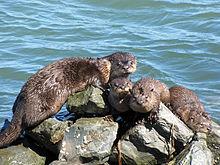
After a baby Grey Whale was beached on the Point Richmond shore in May 2007, its rotting corpse became bothersome to neighbors. It took a while to remove it since various agencies argued over whom would have to pay for it.
Richmond is also home to one of the last pristine moist grassland habitats in the entire Bay Area at the former Campus Bay UC Berkeley Field Station near Meeker Slough.
In 2006 the city was sued by an environmental group for dumping raw sewage into the Bay. Councilmember Tom Butt was very vocal on the accusing the city council of turning a blind eye to the problem.
Mayor McLaughlin has set a goal of installing 5 megawatts of solar photovoltaic generation in Richmond.
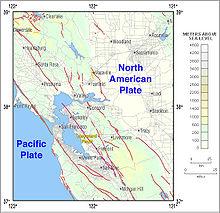
Richmond lies in the volatile California region that has a potential for devastating earthquakes. Many buildings were damaged in the 1989 Loma Prieta earthquake. There was also minor damage in the Richmond earthquake in 1995. The city has also had at least one minor tornado. The Chevron Richmond Refinery often releases gases and had many highly noted chemical leaks in the 1990s. The company has been fined thousands, sometimes hundreds of thousands of dollars. The chemicals most often released are chlorine and sulfur trioxide.
In a July 26, 1993, industrial accident, a General Chemical company rail tanker car containing oleum overheated and exploded in the General Chemical railyard. This resulted in a 17-mile (27 km) area contaminated with the poisonous gas, and led to 25,000 people landing in the hospital. The incident led to lawsuits, and has been referred to as a mini-Bhopal.
In 2006 an explosion at the Chevron Richmond Refinery left hundreds in hospitals but nobody died.
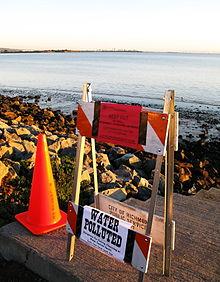
The city's shoreline and wildlife were seriously affected by the 2007 San Francisco Bay oil spill. Beaches and shoreline were closed, but later reopened. Keller Beach was closed to public access for swimmers.
On April 15, 2010, a sinkhole (roughly 30 feet / 9 m deep) appeared at the intersection of El Portal and Via Verde. Although no one was hurt, a car fell into the sinkhole.
There are 17 emergency warning sirens in the city, they are tested every Wednesday and are usually used to warn of toxic chemical releases from the Chevron Richmond Refinery.
On October 24, 2009, a 15-year-old girl was gang-raped at Richmond High School for 2 ½ hours. The crime happened during the high school's home coming dance event.
In March 2010, #3 Most Dangerous City ae Richmond, California The second California city in the top ten list of most dangerous cities in the United States ranks as number 3 in terms of auto theft and terms of murders.
The 2010 United States Census reported that Richmond had a population of 103,701. The population density was 1,976.0 people per square mile (762.9/km ²). The racial makeup of Richmond was 32,590 (31.4%) White, 27,542 (26.6%) African American, 662 (0.6%) Native American, 13,984 (13.5%) Asian (4.0% Chinese, 3.5% Filipino, 1.6% Laotian, 1.2% Indian, 0.7% Vietnamese, 0.6% Japanese, 0.4% Korean, 0.2% Pakistani, 0.1% Thai), 537 (0.5%) Pacific Islander, 22,573 (21.8%) from other races, and 5,813 (5.6%) from two or more races. Hispanic or Latino of any race were 40,921 persons (39.5%). Among the Hispanic population, 27.3% are Mexican, 4.7% Salvadoran, 1.7% Guatemalan, 1.2% Nicaraguan, 0.5% Peruvian, 0.5% Puerto Rican, and 0.3% Honduran.
The Census reported that 102,118 people (98.5% of the population) lived in households, 670 (0.6%) lived in non-institutionalized group quarters, and 913 (0.9%) were institutionalized.
There were 36,093 households, out of which 13,487 (37.4%) had children under the age of 18 living in them, 14,502 (40.2%) were opposite-sex married couples living together, 6,931 (19.2%) had a female householder with no husband present, 2,585 (7.2%) had a male householder with no wife present. There were 2,538 (7.0%) unmarried opposite-sex partnerships, and 427 (1.2%) same-sex married couples or partnerships. 9,546 households (26.4%) were made up of individuals and 2,707 (7.5%) had someone living alone who was 65 years of age or older. The average household size was 2.83. There were 24,018 families (66.5% of all households); the average family size was 3.43.
The population was spread out with 25,800 people (24.9%) under the age of 18, 10,364 people (10.0%) aged 18 to 24, 30,846 people (29.7%) aged 25 to 44, 26,109 people (25.2%) aged 45 to 64, and 10,582 people (10.2%) who were 65 years of age or older. The median age was 34.8 years. For every 100 females there were 94.8 males. For every 100 females age 18 and over, there were 92.0 males.
There were 39,328 housing units at an average density of 749.4 per square mile (289.3/km ²), of which 18,659 (51.7%) were owner-occupied, and 17,434 (48.3%) were occupied by renters. The homeowner vacancy rate was 2.5%; the rental vacancy rate was 8.1%. 52,683 people (50.8% of the population) lived in owner-occupied housing units and 49,435 people (47.7%) lived in rented housing.
As of the census of 2000, there were 99,216 people, 34,625 households, and 23,025 families in the city. The population density was 3,309.5 people per square mile (1,277.8/km ²). There were 36,044 housing units at an average density of 1,202.3 per square mile (464.2/km ²). The racial makeup of the city was 36.06% black or African American, 21.36% white, 0.64% Native American, 12.29% Asian, 0.50% Pacific Islander, 13.86% from other races, and 5.27% from two or more races. 26.53% of the population were Hispanic or Latino, of any race.
Of the 34,625 households, 33.7% had children under the age of 18 living with them, 40.5% were married couples living together, 20.1% had a female householder with no husband present, and 33.5% were non-families. 26.2% of all households were made up of individuals and 7.4% had someone living alone who was 65 years of age or older. The average household size was 2.82 and the average family size was 3.44.
In the city the population was spread out with 27.7% under the age of 18, 9.9% from 18 to 24, 31.4% from 25 to 44, 21.2% from 45 to 64, and 9.9% who were 65 years of age or older. The median age was 33 years. For every 100 females there were 94.6 males. For every 100 females age 18 and over, there were 91.2 males.
The median income for a household in the city was $44,210, and the median income for a family was $46,659. Males had a median income of $37,389 versus $34,204 for females. The per capita income for the city was $19,788. About 13.4% of families and 16.2% of the population were below the poverty line, including 23.1% of those under age 18 and 11.8% of those age 65 or over.
75.4% of inhabitants over the age of 25 were high school graduates, while 22.4% had bachelor's degrees, and 8.3% had a graduate or professional degree. 7.7% of the population was unemployed and those who were employed took, on average, 34.3 minutes to commute to their place of work.
33.2% of the population aged 15 and over has never married, while 46.3% is currently wed. 11.1% have already divorced, 3.1% is currently separated, and 6.4% has been widowed.
20.6% of the population was born outside the U.S., of which 15.4% were born in Latin America and 8.7% in Asia.
During the day the population shrinks by 6.2% due to commuting while 23.3% of the population works within the city limits. 20.5% of the jobs in the city are in the educational, health, and social service fields, while 10.9% are professional, scientific, management, administrative, and waste disposal, and 10.4% are in retail.
7.0% of Richmonders are veterans of the U.S. Armed Forces compared with 10.9% nationally. 33.2% are foreign born while 12.4% are nationwide. 48.1% of men and 43.2% of women are married conversely 55.9 and 51% of Americans are respectively. Nearly half (46.7%) speak a language other than the English language at home. 65.3% are employed even with the national average. The average household income is US$52,794; $6,552 higher than the national average. The average family makes 57,931 dollars while the average American household makes 55,832 dollars. The per capita income is 22,326 compared with 25,035 federally.
Among Richmond residents, 64.56% residents speak English, 23.13% speak Spanish, 2.11% speak Tagalog, 1.75% speak Chinese, 1.20% speak Miao aeMien, 1.12% speak Laotian, 0.72% speak Punjabi, 0.54% speak Cantonese, 0.51% speak French, 0.5% speak Vietnamese, 3.49% speak other languages none of which represents more than half of one percent of the population.
Many industries have been and are still sited in Richmond. It had a dynamite and gunpowder works (the Giant Powder Company, closed in 1960, now the site of Point Pinole Regional Shoreline), the last active whaling station in the country at Point Molate (closed in 1971), and one of the world's largest wineries (Winehaven), closed by Prohibition in 1919.
During World War II, Richmond developed rapidly as a heavy industrial town, chiefly devoted to shipbuilding. Its major activity now is as a seaport, with 26 million tons of goods shipped through Port Richmond in 1993, mostly oil and petroleum products. Chevron USA has a major oil refinery in the city, with a storage capacity of 15 million barrels (2,400 m ³). The Social Security Administration employs over 1,000 at its regional office and program service center in Downtown Richmond. Kaiser Permanente's Richmond Medical Center hospital in the Downtown Richmond is one of the largest employers in the city. Galaxy Desserts is run and operated in the city. Vetrazzo, an award winning green business that manufactures Recycled Glass Countertops out of waste glass such as beer bottles and old traffic lights, is located in the refurbished Ford Assembly Plant. Treeskunk Productions a video game animation studio is based in the town. Bay View recording studios are located in the city, and have worked with artists such as Smash Mouth. Photon Films, LLC, a video production and editing studio, is located in Harborfront area along the southeast shoreline.
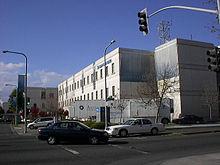
The Hilltop District includes Hilltop Mall that features Sears, J.C. Penney, Macy's, and Wal-Mart department stores as anchors. Furthermore the area is home to Hilltop Auto Mall, a 16 screen Century Theaters alongside, Hilltop Plaza Shopping Center.
The 23rd Street business district has evolved into a predominantly Latino neighborhood over the last twenty years as have the storefronts.
In the Downtown Richmond District the Richmond Shopping Center was built as part of the city's "main street" revitalization efforts. It is anchored by a Foods Co. supermarket and a Walgreens pharmacy.
The Macdonald 80 Shopping Center is a commercial plot along the trunk route of Macdonald Avenue which has been designated the city's main street under the aforementioned program. It was once anchored by the now-defunct Montgomery Wards and a Toys"R"Us. Demolition of the former buildings and construction of a new shopping mall were completed in 2006 and the center is now anchored by a Target store.
"Big-box" stores already in the city include Costco in the Point Isabel area and a Home Depot which is partially in Richmond. A controversial Kohl's department store has been proposed for Point Isabel. (See Point Isabel)
The city's adjacent Richmond Annex neighborhood is home to a chinatown that is anchored by the Pacific East Mall, an Asian mall.
The former Richmond Shipyards were transformed starting in the late 1980s into a multiunit residential area, Marina Bay. Starting in the early 2000s, the city began an aggressive redevelopment effort spurring exurban tract housing, condominiums, townhomes, a transit village, and terraced hillside subdivisions. The city also created a redevelopment agency that refurbished Macdonald Avenue, funded the Metro Walk transit village, resurrected the Macdonald 80 Shopping Center, and created the Richmond Greenway rails-to-trails trail and urban farming project. Since 1996, new homes have increased in price by 32%, and there has been a 65.6% increase in the total amount of new dwellings built annually.
Country Club vista is a development surrounding the Richmond Country Club to the south and north. It includes suburban style tract houses with cul-de-sac courts and small yards. Seacliff, at Point Richmond, is a development of luxury waterfront homes built on a terraced hillside. San Marcos is a series of about ten condominium multistory buildings between Hilltop Mall and Country Club Vista. Richmond Transit Village has been constructed in the former west parking lot and an adjacent empty lot of the combined Richmond BART and Amtrak station. The development is part of the city's downtown revitalization efforts.
Many casinos have been proposed for the West Contra Costa area. Point Molate would have a casino, resort, and a luxury shopping mall. Sugar Bowl Casino proposes a casino, steakhouse, and a buffet promoted by the Pomo Tribe's Scotts Valley Band near the border between North Richmond and the city of Richmond's Parchester Village whose resident's have lauded as a boon to fight crime by adding more of a police presence and creating jobs for shiftless youth, but residents from neighboring newly developed sub-divisions along the Richmond Country Club were fervently opposed based on potential losses to property values. Casino San Pablo has already been built in neighboring San Pablo, with 2,500 slots. The projects have been the subject of much civic debate supporters contend that the often cash-strapped government would get a major new source of revenue, while opponents air their concerns over the ramifications including an increase in already high crime rates, lowered property values, and worsening neighborhood quality of life.
Point Molate is currently slated to either become a housing and conference center or a casino resort shopping area, or even a large regional park.
In 2010 the city approved the environmental review of the plan in which the tribe agreed to contain development of the casino to the footprint of the buildings on the former naval depot site. The lobbying and reports required by Richmond have cost the tribe $15,000,000. This approval won over the regions strict environmentalists and many council members. Later that year residents were given the opportunity to weigh in the issue and voted on the non-binding measure U to determine their approval of the project. 58% of voters opposed the 1 billion dollar project. Citing the people's opposition and the inability to negotiate several key points with the developer the city council voted down the project in 2011. Councilman Nat Bates remained a proponent of the plan with its projected 17,000 jobs, the remainder of the council was chagrined at the fact that there was no guarantee that the jobs would go to Richmonders. The city of San Pablo whose lifeline is their card club, Casino San Pablo was elated. The Guideville Band of Pomo Indians were given the opportunity of 150 days to create a non-casino plan for the site such as alternatives in the environmental report for a convention center, conference center, hotel, spa, and housing.
Richmond city government operates under a council-manager system with 9 members (including mayor and vice mayor) elected to alternating 4-year terms. Politically, the city is a Democratic stronghold. By the early 1990s, not a single Republican remained on the council. The city council has four African Americans, four whites and two Latinos.
The position of Mayor rotated between members of the Richmond City Council until 1981, when the office became an elected position. George D. Carroll, who was voted by the City Council to become Mayor on July 6, 1964, was described at the time as "the first Negro mayor in California and first in America with the exception of small, scattered all-Negro communities in the Deep South,". George Livingston Sr. was the first elected African American mayor. He served from 1985 to 1993. Rosemary Corbin served as the mayor from 1993 to 2001. In the early 2000s Gayle McLaughlin was the first Green elected to the council, with the support of the Richmond Progressive Alliance (RPA), a coalition of liberal Democrats, progressive independents, and Greens. In November 2006, McLaughlin was elected mayor, defeating incumbent first-term Mayor Irma Anderson.
In 2006 the city implemented a computer program that it had ordered from a German firm that provides the city with statistical interactive maps. These maps cover such areas as signage locations, streets, crime hot-spots, and zoning information. In 2007 the city won a contest in which its previously substandard website was upgraded and improved to make it more modern and functional. The prize includes 2 years of free webmastering.
There has recently been controversy regarding appointments of councilpersons Sandhu and Thurmond who were not elected at-large or were appointed to the ballot on a Yes/No basis.
Recently Mayor McGlaughlin and Councilperson Butt have opposed Chevron's plans of modifications to the refinery that would increase pollution by using dirtier, thicker, but cheaper crude oil.
The city of Richmond has eight community centers which are located within city parks. Many of the city's community centers were closed in the early 2000s following budget miscalculations and financial difficulties. In the 2006 city elections many candidates ran on platforms promising to reopen these community centers, most of which had been closed due to budget cuts. That election also featured a city sales tax increase, Measure Q, which failed.
There are 53 voting precincts in Richmond. During the regular election on November 7, 2006 21,575 of 37,605 (57.37%) registered voters cast their ballots.
Richmond has formerly been home to black culture and activist movements, most notably the Black Panther Party.
The city has eight marijuana dispensaries and although the city has passed legislation approving them and has legalized their presence, the city management does not since it had sued to close them, for operating from partially to blatantly illegally. It is trying enforce an injunction supporting removing their operating licenses. The problem is that although the city council has passed an ordinance permitting them the city management refuses to cooperate with the spirit of the law because it has yet to take effect. The question remains if the clubs will be closed before the law takes effect allowing them to open. A moratorium on new clubs expires in January 2011 with no political will to renew it. Furthermore the city taxes medical cannabis at 2% and recreational marijuana at 10%.
Richmond is served by the Richmond Police Department and Richmond Fire Department. Dozens of parks are run by the Richmond Parks & Recreation Department. The Richmond Civic Center is currently undergoing a seismic upgrade and renovations program. Some buildings are being refurbished while other buildings will be replaced.
The city received widespread attention in 2009 when a girl was gang raped at a homecoming dance at Richmond High School.
The city has in recent years suffered from a high crime rate, so serious that the city council at one point requested a declaration of a state of emergency and asked for the intervention of the Contra Costa County Sheriff and the California Highway Patrol in order to ameliorate the crime rate. Murder, vehicle theft and larceny rates are all high, although they tend to be concentrated in certain areas such as the Iron Triangle and areas surrounding adjacent unincorporated North Richmond, which is outside the jurisdiction of the Richmond Police Department.
In 2004, Richmond was statistically the most dangerous city in California and was named the 8th most dangerous city in the country. Those rankings have changed and Richmond is now the third most dangerous in California behind Compton and Oakland and 11th most dangerous nationally according to the Morgan Quitno rankings. For every 100,000 people there were 38.3 murders, 50.4 rapes, 485.8 robberies, 512 assaults, 1110.7 burglaries, 3497.4 counts of larceny and 2471.4 thefts of vehicles. Richmond had 42 murders in 2006; and the city experienced a record of 62 homicides in 1991 out of a population of 98,000, which was 7 times the national average.
Current mayor Gayle McLaughlin is a member of the Mayors Against Illegal Guns Coalition, an organization formed in 2006 and co-chaired by New York City mayor Michael Bloomberg and Boston mayor Thomas Menino. The city is also participating in the California Cities Gang Prevention Network. Gangs are a serious problem for the police department as they cause violence and shootings. Many gangs graffiti their "tags" to mark their territory thus blighting the city with vandalism. A high-ranking MS-13 (or mara salvatrucha) leader, Jose Santos Bonilla, was captured in the southwestern Annex neighborhood in 2006.
Richmond is also home to the West County Detention Center in the Point Pinole area. It is a male and female county jail.
RichmondWorks and Richmond Summer YouthWorks are city programs which aim to decrease unemployment and crime and have led to hundreds receiving employment at area retail businesses.
Fires, medical emergencies and other disasters are handled by the Richmond Fire Department which has seven fire stations in the city. Medical and trauma patients are transported by American Medical Response Paramedics and EMTs.
Sewage is largely handed by the Richmond Sewage Treatment Plant in Point Richmond.
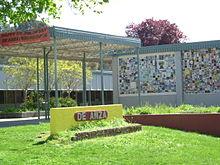
The public schools in Richmond are administered by the West Contra Costa Unified School District, formerly the Richmond Unified School District. There are also many private schools, mostly Catholic schools under the authority of the Diocese of Oakland.
The city has five high schools: De Anza High School, Salesian High School, Richmond High School, and Kennedy High School . In addition, there are two charter high schools, Leadership Public Schools: Richmond and West County Community High School. There are also three middle schools, sixteen elementary schools, and seven elementary-middle schools. Richmond also hosts three adult education schools.
The Contra Costa Community College District serves all of Contra Costa County, and Richmonders who decide to attend a community college typically go to Contra Costa College, located in the neighboring city of San Pablo.
79.8% of Richmonders have a high school diploma or equivalent compared with 84.2% nationally, however 27.1% have a bachelor's degree compared with a statistically similar 27.2% countrywide.
Since the implementation of an exit exam requirement for California high schools, the CAHSEE, some Richmond high school students have been protesting the requirement. Some students were angered by the new CAHSEE requirement. They sued the district in the pursuit of eliminating the requirement. In July 2007 a compromise was reached in which the district would provide 2 additional years of educational assistance for the purposes of passing the exam. That year, only 28% of Richmond High School students had passed the CAHSEE, a prerequisite for graduating.
All Richmond schools have banned junk food, such as candy, soda, Twinkies, pizza, and other like items in attempt to curb childhood obesity and change children's eating habits. It has been speculated that this was done preemptively since some believe the state will soon mandate such restrictions. Irrespectively access to sodas in schools has not diminished whatsoever. Furthermore the current 32% of obese Richmond children will skyrocket the current 24% adult obesity rate to 42% according to the Contra Costa County Health Services. This led the city council to approve a referendum on a 1 cent per ounce tax on sugary beverages for the 2012 elections, a first in the nation. The measure is opposed by councilmembers Corky Booze who and Nat Bates who stated that he knew "many obese people that are perfectly healthy" and that it was "elitist" and "targeted black" people respectively. Members Jovanka Beckles and Jeff Ritterman the later a cardiologist expressed horror at the obesity rate and Beckles chastized the other black members (Bates and Booze) for not supporting the measure as she found that the epidemic most effected people of color like themselves. The revenues will be used to counter obesity through health and fitness campaigns and expenditures.
The city of Richmond has dozens of parks, National Historic Park, and 10 sites listed under the National Register of Historic Places.
Point Richmond, which is in effect a village within Richmond, is known for its small-town charm and its quaint shops. The Point, as it is known by locals, offers owner-operated stores, coffee shops, and historic benches and streetlights. The Masquers Playhouse is a performing arts center that offers shows and productions year round. Hotel Mac is one of the oldest buildings in the area and has classic early 20th century architecture, like many other buildings in the area. There is also The Plunge, a natatorium which had been closed due to seismic safety issues but was re-opened in August 2010 after the retrofitting was completed. The city expressed a desire to demolish the building at one point, but this was halted by the actions of a neighborhood preservation campaign which continues its mission to "Save the Plunge!".
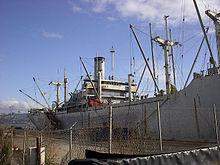
The Ferry Point Tunnel is one of the oldest tunnels in California. Built in 1899, this structure still gives access to many attractions and neighborhoods in Brickyard Cove. The tunnel goes to the Golden State Railroad Museum, the USS Red Oak Victory, and many beaches and parks, and to Ferry Point where an abandoned ferry-rail pier still stands with a historic ferry slip still standing, though somewhat damaged by fire. It can be viewed from an adjacent fishing pier.
The USS Red Oak Victory (AK-235) is a restored World War II Victory ship, the 558th ship made in Richmond. Liberty and Victory ships transported troops and supplies during World War II.
During World War II the city sprawled and its population increased dramatically. This led city leaders to construct the Richmond Civic Center in 1957. This center houses the city hall, a small convention center, library, hall of justice, police headquarters, and arts center.
The Richmond Public Library, the only public library independent of the Contra Costa County Public Libraries system, lies in the heart of the civic center. It houses over 204,686 books, 4,014 audio materials, 5,277 video materials, and 491 serial subscriptions.
The Richmond-San Rafael Bridge extends 5.5 miles (8.9 km) across San Pablo Bay. The bridge is the origin of the term rollercoaster span, due to its curves, bumps, and appearance which have also earned the bridge the nickname of The Rollercoaster Bridge. It was built in 1957, and connects Contra Costa County with Marin County. Automobiles are charged a $5 toll in the westbound (towards Marin) direction only.
The Golden State Railroad Museum is a complex series of model railroad layouts in a museum in the Brickyard Cove area of Point Richmond. A visitor can operate trains of various eras, and there are miniature freight and passenger terminals, trestles, tunnels, and meticulously detailed town and city scenes, many of which are copied from real life scenes of the 1950s.
The Santa Fe Railroad Terminal operated as the western terminus for the railroad from the late 19th century to the late 20th century. It has now been transformed into a museum to exemplify the feel of the terminal in that era.
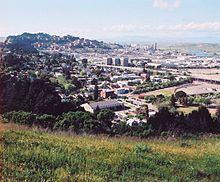
The Rosie the Riveter/World War II Home Front National Historical Park is in Richmond, and commemorates women's shipbuilding and support for the war effort in the 1940s.
Keller Beach is one of the city's beaches, located at Miller/Knox Regional Shoreline, a park in Brickyard Cove. It offers picnicking, sunbathing, wading, and swimming. The beach is overlooked by vehicles exiting the Brickyard Cove drive, Ferry Point tunnel and houses on the steep cliffs above. The beach, as with most of the cove, offers spectacular panoramic bay views of the Oakland hills, bridges, the San Francisco skyline and the Golden Gate.
Point Molate Beach Park is a park on the western coast of Richmond along Western Drive. It was originally a Chinese shrimp camp in the 1870s.
Point San Pablo yacht harbor accommodates hundreds of private boats.
East Brother Light Station on East Brother Island (one of the Brother Islands) is host to an exclusive bed and breakfast. It is only accessible by private boat. Visitors come and stay for the day and picnic for free or they may pay for a room.
The city also is also home to a radio controlled model airplane airport, Breuner Airfield that is located in Breuner Marsh a contested piece of land and near Point Pinole Regional Park in the Parchester Village neighborhood.
The city's cemeteries include Rolling Hills Memorial Park and St. Joseph Cemetery.
Several regional parks administered by the East Bay Regional Park District lie within the city, including the Miller/Knox Regional Shoreline and the Point Pinole Regional Shoreline. They are linked by the San Francisco Bay Trail. Part of the former shipyard is now a marina.
The Richmond Art Center, founded by Hazel Salmi in 1936, is one of the oldest continually operating non-profit art centers on the entire West Coast of the United States. Its programming includes exhibitions, adult and youth education, and community initiatives. The Center currently (as of 2005) provides some of the only arts education programming in the Richmond City School District, relying primarily on public donations and private grants as its means of support.
There is also the East Bay Center for the Performing Arts, Hilltop Multiplex, or Masquers Theaters in Point Richmond.
The Richmond Progressive Alliance and Green Party are active political parties in Richmond. The House Rabbit Society has its national headquarters in Richmond.
Richmond is home to the National Institute of Art and Disabilities Art Center, also known locally as the NIAD Art Center. NIAD is a non-profit organization hosting over sixty client artists weekly. NIAD's client artist's work can be seen at NIAD's on-site gallery, the Florence Ludins-Katz Gallery. NIAD has a gift shop. The Richmond Art Center hosts the annual "The Art of Living Black," art show which is a showcase of the artwork of Bay Area Black Artists. "Featuring over 50 local artists, the works include fine arts and crafts, paintings, sculpture, photography, prints, masks, stained glass, quilts, textile art, ceramics, jewelry and dolls." The beauty, the pain, the power and the eye of these black artists touch the soul deeply.
The Hyphy subculture and sub genre of rap music originated in Richmond and surrounding cities.
From 1996 to 2002 a "geekfest" was held on the beach in Point Molate every few weeks or monthly by S.P.A.M. Records. The festival was a community service for under-21-year-olds.
There are dozens of gathering places for various religions in the city, and some which are not represented in the city can be found nearby. Christian denominational churches include the Kingdom Hall of Jehovah's Witnesses; Word of Faith church; Kingdom Land Baptist Church; Grace Baptist Church; Grace Lutheran Church; Temple Baptist Church; Unity Church of Richmond; Holy Trinity Episcopal Church; Holy Mission Christian Center; St. David Catholic Church, Faith Temple C.O.G.I.C., and Faith Tabernacle A.O.H. Church Of God; and the Largest Church in Richmond, Hilltop Community Church which is Assemblies of God. There is also a large Laotian Buddhist temple that serves as a community center for the Lao community of the East Bay. There is a synagogue in the Hilltop Green District.
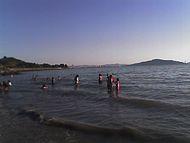
The city has 292.6 acres (1.2 km2) of parkland, that is 1.5% of the city's land territory. A new national park, Rosie the Riveter World War II Home Front National Historical Park is now under construction in the former Kaiser shipyards and other wartime industrial sites in Richmond. The park is a memorial to the six million women who labored on the home front, symbolized by the mythical figure "Rosie the Riveter". Richmond was selected for the park because it has many intact buildings that were constructed for 56 wartime industries. Its four shipyards produced an amazing 747 large ships and set production records. The home front changed Richmond from a predominantly rural community of 23,600 residents to a diverse population of over 100,000 people within a year. Industries operated around the clock and public housing, schools, day care centers, health care and merchants mobilized to support the new workforce that arrived on the city's doorstep. Fortunately, Richmond's turbulent and productive home front years were well chronicled and photographed. The National Park Service provides interpretive services and operates a Visitor Center in the craneway of the Ford Assembly Building.
Richmond also has number of local parks and two large regional parks are under the authority of the East Bay Regional Parks District, a consortium of most of the Parks and Recreation lands and facilities of Alameda and Contra Costa County.
Wildcat Canyon Regional Park is the city's largest park at 2,428 acres (10 km2). The park once housed a dance hall and roller rink and has distinctive stonework throughout, which was the rationale for its placement on the National Register of Historic Places. It features San Pablo Creek, trails, forests, horseback riding, picnic areas, and a play structure for children, as well as horses for rent and mountain biking trails. High school students practice cross-country in the park. It is situated in the eastern Richmond hills and stretches into Berkeley's Tilden Regional Park in Alameda County. The park has diverse animal and plant life including great horned owls, opossums, king snakes, rubber boas, turkey vultures and many others.
Point Isabel Regional Shoreline is the largest off-leash dog park in the United States.
The Richmond Greenway is a project costing millions of dollars to transform an old rail line into a walking, jogging, and biking trail. It will span east to west from the end of the Ohlone Trail that follows the BART line from El Cerrito to Berkeley. It will also follow the BART line to Richmond station and continue to Point Richmond. Pedestrian bridges will be used to cross major avenues such as San Pablo Avenue and 23rd Street. An additional side project will add a bike lane/bike trail between the Richmond Greenway and the Ohlone trail at Potrero Avenue via 23rd Street, Carlson Boulevard, Cutting Boulevard, and Potrero. It is currently under construction.
Richmond is home to four marinas: the Brickyard Cove Yacht Club, Point San Pablo Yacht Club, Marina Bay Marina, and Channel Marina in the Santa Fe channel. In addition, Richmond has the "Richmond Plunge", a municipal natatorium dating back to 1926 and which reopened August 14, 2010. The pool is located in the Point Richmond neighborhood.
The city has annual Juneteenth and Cinco de Mayo celebrations. The Cinco de Mayo celebrations sponsored by the 23rd Street Merchant's Association attracts thousands and closes the entire length of the roadway. The Richmond Police Department, Fire Brigade, United States Marine Corps and other organizations participate in the parade. This is in addition to a fireworks show at Marina Bay celebrating the 4th of July and a Silly Parade, an event where people march down the street and generally act "weird" and silly. The city also participates in various Earth Day activities. The city hosts an annual and a physical activity and nutrition forum to discuss health in the community, it has been running since 2006. In 2010 the city began celebrating the Richmond Native American Pow-Wow in Nicholl Park, in 2012 this included area politicians and members of over 50 tribes from throughout the country.
There are two African American weekly newspapers, one general interest online publication, and one multimedia news project that cover Richmond exclusively. The Richmond Post and Richmond Globe publish print and online editions. RichmondConfidential.org, which is run by the UC Berkeley Graduate School of Journalism, is a general interest online-only news publication serving the city of Richmond. Richmond Pulse is a youth-led print and online publication which focuses on community health. The West County Times, run by Media News Group, covers greater Contra Costa County.
A local cable TV station, KCRT-TV, mainly plays historical archives but also airs Government-access television (GATV) City Council Meetings and music videos.
KKSF (AM) transmits from towers at Point Isabel.
The Port of Richmond, located in along the city's southern coast beside the Richmond Inner Harbor, handles the third-largest shipping tonnage in California annually, a total of 19 million short tons. It ranks number one for ports of the San Francisco Bay for vehicles and liquid bulk. In addition to these commodities, the port can also handle dry-bulk, break-bulk, and containers. Seven of the terminals are city-owned, in addition to 5 dry docks, while there are 11 privately owned terminals. The port is served by a rail network operated by four major rail companies.
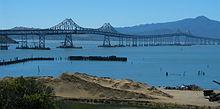
Amtrak provides intercity passenger rail service from Richmond Station, an intermodal connection shared with the BART system. The station is located downtown and has a transit center with connections to AC Transit and Golden Gate Transit buses as well as taxis.
There are two Amtrak lines serving this station. The regional San Joaquin Route runs from nearby Oakland to the south through Richmond and Martinez to the Central Valley through Stockton and Fresno, terminating in Bakersfield. Passengers continuing on to Los Angeles or other points in Southern California may transfer at Bakersfield for connecting Amtrak Thruway bus services.
The second Amtrak line, the Capitol Corridor runs from San Jose to the state capitol, Sacramento, through Richmond, Fairfield, and Davis; some trains continue to the northern Sacramento suburb of Auburn. This route is the third most heavily used Amtrak line in the United States.
BART has one station in the city of Richmond, mentioned above, which serves as the northern terminus of the Richmond-Millbrae and Richmond-Fremont lines. Two other stations are located near Richmond, El Cerrito del Norte and El Cerrito Plaza, both in El Cerrito. The Richmond BART station had over 1.7 million passengers in 1998 while the Amtrak station carried 238,893 in 2006.
Before AC Transit and BART the Key System provided a network of several rail lines on the East Shore and Suburban Railway.
AC Transit provides 14 bus lines in the city including local service throughout the city including BRT line 72R along San Pablo Avenue, "Transbay" commuter service across the Bay Bridge to the San Francisco Transbay Terminal and also owl "All-Nighter" service along the BART line. The lines are: 7, 29, 70, 71, 72, 72M, 72R, 74, 76, 376, 800, H, L, LC, LA
In June 2007, after engaging with the community for feedback with public hearings, AC Transit implemented the West Contra Costa County Service Plan which realigned existing service finds to reroute portions of certain lines, eliminate service to areas with low ridership, and replace service in some areas with service from a different route providing direct service to areas previously requiring tedious transfers. Furthermore, a great effort was made to provide a better transfer at Richmond Station as well as the Richmond Parkway Transit Center. The changes are covered by Phase I and use no new monies which would be required to completely implement the plan: Phase II. Phase II will use Regional Measure J funds to expands service providing lines along corridors which are undeserved or not served, and increasing hours and decreasing headways. Two of the greatest changes will be extending BRT service to Richmond Parkway Transit Center and providing service along the Ohio Avenue corridor. These changes have effected the northern neighborhoods of the city and the adjacent communities of El Sobrante and San Pablo the most. Phase I was originally supposed to be implemented in late 2006, but the implementation has been delayed until June 2007. Phase II has a target date of mid-2008.
Golden Gate Transit provides a service from San Rafael in Marin County across the Richmond-San Rafael Bridge to Richmond and El Cerrito del Norte BART stations with routes 40 and 42.
Vallejo Transit (line 80) and Fairfield/Suisun Transit (line 85) and Napa VINE (line 29) provide feeder services from the North Bay counties of Solano & Napa, primarily Vallejo but also Fairfield, Vacaville, and Napa and other cities to El Cerrito del Norte BART, these busses pass through Richmond.
WestCat provides similar feeder service from other West County cities like Pinole and Hercules. In addition to service in northern Richmond's Hilltop neighborhood. Lines running through Richmond are: 16, 17, 18, 19, 30Z, C ³, J, JX, JPX Carlson Boulevard is the primary access from Downtown Richmond to the Richmond Annex neighborhood, starting from 23rd street and terminating at San Pablo Avenue just north of the Alameda-Contra Costa county boundary, feeding into the El Cerrito Plaza shopping center.
Bear Transit provides commuter and student service from El Cerrito BART and UC Berkeley to the UC Field Station in Campus Bay on route RFS.
Napa VINE offers commuter service from Napa County.
The Union Pacific Railroad (UP) has a mainline passing through Richmond. This line was formerly operated by the Southern Pacific Railroad (SP).
The BNSF Railway (BNSF) has a yard and that serves as the Northern California terminus of their line that goes to their main classification yard at Barstow, CA via the San Joaquin Valley. The track was formerly operated by the Atchison, Topeka and Santa Fe Railway (ATSF). Many years ago, the ATSF offered rail car ferry service from Point Richmond to San Francisco. The partially burnt remnants of the ferry pier can still be seen at Point Richmond.
The Richmond Pacific Railroad (RPRC) is a class III shortline railroad operating on 2.5 miles (4.0 km) of track, providing switching services at Richmond's wharves. The RPRC is owned by the Levin-Richmond Terminal Corporation and was formerly known as the Parr Terminal Railroad (PRT).
Richmond had commuter ferry service from the Richmond Ferry Terminal to the San Francisco Ferry Building on weekdays and Fisherman's Wharf on weekends in addition to special Giants Ballpark service during the baseball season. The voyage took approximately 45 minutes one-way. The service began in 1999, but was discontinued in the late 2000s in the economic downturn following the dot-com bust. Ferry ridership plummeted and the service became economically unsustainable, which led Red and White Fleet to discontinue the service. The Richmond ferry terminal is at Ford Point located adjacent to the historic Ford Plant in Marina Bay which is now open as an industrial park and under renovation. The terminal had its own dedicated AC Transit feeder service from Point Richmond and downtown Richmond with route 374 also now discontinued.[100][101] A new ferry service from Richmond is planned for 2008 by the San Francisco Bay Area Water Transit Authority. The new ferry will take only half an hour to San Francisco and will use the existing terminal and parking facilities at Ford Point.[102] Recently most of the city council except Tom Butt and Mayor McLaughlin have lost interest in the project instead supporting using the site for expanded Toyota vehicle importation parking which that company has expressed an interest in.[103]
The city has aggressively developed its portions of the San Francisco San Francisco Bay Trail and has more than any other city at present. The total is 17 miles (27 km)[104] and more is to be built. The city is also currently developing the Richmond Greenway a rails to trails project running parallel to Macdonald Avenue which will feed into the Ohlone Trail which serves as feeder service for the El Cerrito del Norte BART station. There is also the Hercules Bikeway connecting the Ohlone Trail with Hercules, which runs along the neighborhoods of East Richmond and El Sobrante. There is a trail under construction along Wildcat Creek to connect the Bay Trail and Wildcat Marsh with Wildcat Canyon Regional Park. The city also has many miles of trails in that park in addition to Miller/Knox, Point Isabel, and Point Pinole parks, among others.

The Richmond-San Rafael bridge (Interstate 580) alongside Red Rock Island and barges crossing San Pablo Bay.

Tree-lined San Pablo Avenue at Macdonald Avenue with an AC Transit BRT stop and businesses in eastern Richmond.

A freight train of the Richmond Short Railroad

Richmond BART Station within the intermodal Richmond Station which carries 1.9 million passengers annually.
The Richmond Fire Department is the fire and rescue service for Richmond, and by contract with Contra Costa County it also serves East Richmond Heights, and North Richmond.[105] The Richmond Police Department is headquartered at the Richmond Civic Center; the headquarters building was recently renovated and is LEED certified.[106] Richmond's waste disposal and recycling is handled by the Richmond Sanitary Service. Water is provided by the East Bay Municipal Utility District (EBMUD), while sewers are operated by the city government. The city's electricity and gas is provided by the Pacific Gas & Electric Company (PG&E).
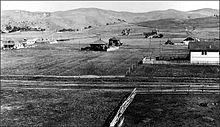
Richmond has many distinct neighborhoods. The city can roughly be divided into the northern Hilltop/El Sobrante, eastern Central/East Richmond, downtown/Iron Triangle and Southern Point Richmond/Marina Bay areas.
Richmond, California has three sister cities, as designated by Sister Cities International:

Word Count: 10148






